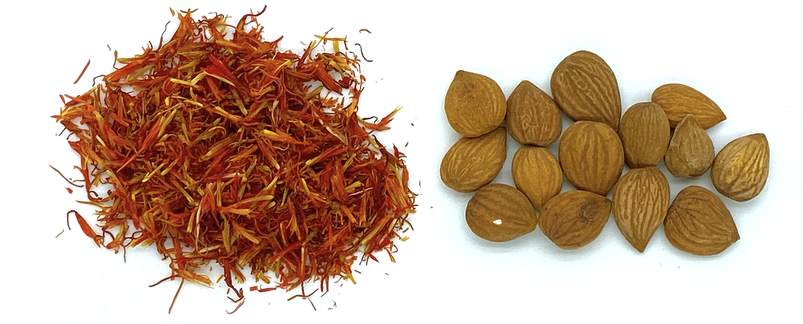Sentry Page Protection
Peach kernel / Bitter Almond kernel & Saffron / Safflower
Bitter Almond kernel and Peach kernel were used synonymously in the Western tradition, and Peach kernel was listed as a substitute for Bitter Almond kernel by several authors. Therefore, these combinations will be considered together.
This is predominantly a TCM combination, Peach kernel and Safflower being commonly used together to move the Blood.
Peach kernel was infrequently used in Greek or European medicine, and appeared in none of the traditionally used Compounds. However, several Midwifery texts listed it to move the Blood. The Midwife to the Queen of France in the mid 1600’s has a formula using Peach kernels for After pains, for example.
However, as stated above, Bitter Almond kernel shares similar functions and was often used in the west.
Safflower is fairly neutral in quality (mildly Warm and Pungent), but light in nature. It moves the Blood, clears Stasis, and eases Pain. As with Saffron, it is a tonic to the Blood in small quantity, moves the Blood in moderate quantity, and breaks Blood in large doses. It clears the channels to enable free flow of Blood.
Peach kernel is also fairly neutral in quality, but is heavier, and slightly moist. It moves the Blood and clears Stasis, but is more focused at moving Blood stasis and clearing Masses when compared to Safflower. It can ‘Break Blood’, the strongest of the TCM categories of Blood-moving medicines. It is also moistening, which is beneficial because chronic Blood stasis either comes from, or causes, dryness.
When combined together, they elegently support each other to achieve the desired effect far more effectively, a true example of synergism. This combination can be added to many different formulas where blood moving is required. This combination is often used in Gynecology, Trauma, and in the treatment of Fibroids, Tumors and Cancers.
Dose: 3-9 grams of each in decoction; 1-3 grams each of the powder. Use one-third doses for a child. Usually combined with Blood tonic medicines such as Dang Gui or Peony.
Examples:
Greater Gum Lacca Powder (Mesue), Electuary of Peony, Electuary for Paralysis
Mesue and his contemporaries had several formulas very similar for chronic obstruction of the Liver and Spleen, some of which combined Bitter Almond and Saffron.
Additions:
1. For Blood deficiency, add Peony and Angelica root (or Si Wu Tang of TCM).
2. For Pain from Qi and blood stagnation, add Cyperus and Costus root
3. For Pain from Trauma, combine with Comfrey root
4. In obstinate cases of Blood stagnation, add Myrrh and Frankincense.
5. For Menstrual Pain associated with Blood stagnation, manifested with dark or clotted blood, combine with Motherwort.
6. Paralysis add Annis, Nutmeg and Elecampane as in Electuary for Paralysis.
Cautions:
1. Large doses should only be used for cases of severe Blood stagnation. Use cautiously in cases with severe Blood deficiency.
2. Avoid during pregnancy.
3. Peach kernels can be toxic in overdose.

